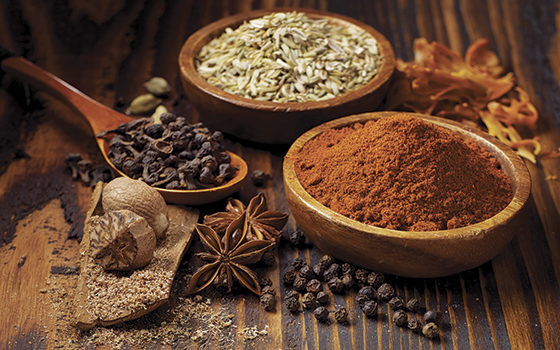I love to travel, and when I get back to Quebec, I love discovering new recipes and changing up my dishes to let that vacation feeling last a little longer. A simple and inexpensive way to give a dish a dash of the exotic is to use spices, herbs, and seasonings.
Spice, seasoning or condiment
It’s not easy to navigate through all the various definitions out there. Generally speaking, spices and seasonings are plant-based. While spices are often processed (in particular through drying or fermentation), seasonings are instead added as is to your recipes. Spices therefore have a bolder taste that is more pronounced than seasonings. Condiments for their part are served with dishes and are prepared for this purpose. They include mustard, ketchup, table salt, and so on. Spices and seasonings have been around for thousands of years as part of many of the world’s culinary traditions. Their pairing can create a wonderful explosion of taste in your mouth. But interest in these taste enhancers is nothing new. Since ancient times, convoys of caravans loaded with spices used the Silk Road to deliver these exotic products to the West. We all know the classic spices, seasonings and condiments (salt, pepper, parsley, and so on), but it pays to trod off the beaten path and try less common spices and seasonings.
Here are five of my favourites:
Fennel seeds: In Italy, fennel came from the gods and kept demons and bad spirits at bay. The slightly licorice flavour of fennel seeds gives a dash of the exotic to vegetable dishes, and they are often used to add aroma to marinades and seafood chowders. They also enhance the flavour of homemade breads and crackers. Try them in an infusion as well—you’ll fall for their charm, I guarantee it!
Pink pepper: Pink pepper is not real pepper. Rather it is a berry farmed in Reunion Island, Madagascar, and Peru. This berry has a slightly sweet flavour and is highly aromatic, but not as spicy as black pepper. While it’s often used to infuse fish and green beans, you’ll be surprised by how it enhances a strawberry salad, a goat cheese crêpe, or a dark chocolate dessert.
Garam masala: Garam masala is a blend of spices. It’s very popular in Indian cuisine and actually means “mixture” in Hindi. Proportions of each spice vary depending on who is preparing the mixture, but it almost always includes cumin powder, cardamom, nutmeg, cinnamon, cloves, and pepper. It’s used to season meats and rice, or to add aromas to vegetable dishes.
Lemongrass: Lemongrass is a herbaceous plant that is very popular in south-east Asian cooking. It pairs delightfully with ginger, hot pepper, and coconut. Its dried leaves can be used for marinades, as is often the case in Indonesian and Chinese cooking, and part of its stalk is often added to Thai and Vietnamese soups and stir-fries. Today, more and more mixologists are also using it to create astounding cocktails with lychee or mint.
Juniper berries: Essential for Alsatian sauerkraut and marinades, dried juniper berries also go wonderfully with fish thanks to their acidulous and sweet taste. And when crushed and added to a red wine sauce, they’re a great way to jazz up your traditional blade roasts and braised dishes! In the end, spices, herbs and seasonings should never mask the taste of other ingredients, but rather enhance them. That said, dosage is a matter of personal taste, so try different combinations to find what works for you!
Your Rachelle Béry Team of Dieticians
Trending Now —

